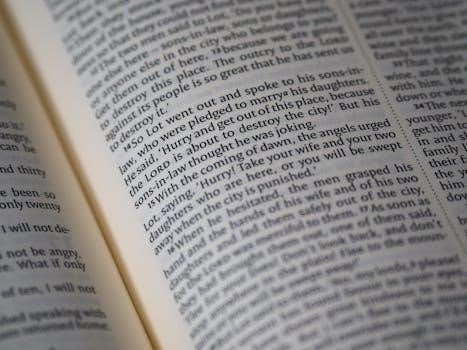the entire book of revelation pdf

The Book of Revelation, a Christian prophecy, uses apocalyptic style and imagery in letter form. It addresses the suffering and salvation of God’s people. Revelation concludes with a vision of restored paradise. It was written between 65-95 A.D. by John, traditionally identified as the apostle.
Purpose and Significance
The primary purpose of the Book of Revelation is to unveil the significance of God’s kingdom and its historical trajectory. It was written during a period of intense suffering, aiming to instill hope in believers by depicting the grand narrative of redemption. This book is a powerful reminder that despite present trials, God’s ultimate victory is assured. It serves as a source of encouragement, assuring that God’s wrath will be meted out to his enemies, while his people will find eternal security in his presence. Revelation’s apocalyptic language is not meant to be a roadmap of future events but a symbolic portrayal of spiritual realities. It provides a vision of the ultimate triumph of good over evil, the establishment of God’s kingdom, and the everlasting dwelling of God’s people in a new heaven and earth. This text emphasizes God’s sovereignty over history and encourages steadfastness in faith during times of persecution. Its message continues to resonate with those seeking comfort in the face of adversity, offering a glimpse into the glorious future.
Author and Dating
The authorship of the Book of Revelation is traditionally attributed to John, identified in the text itself (1⁚1, 4, 9). This John is widely believed to be the apostle, the son of Zebedee, one of Jesus’s closest disciples. The book was likely written during a period of persecution against Christians, which helps establish the timeframe. Scholars generally place the dating of Revelation between 65 and 95 A.D. This period encompasses the reigns of Roman emperors known for their hostility towards Christians, such as Nero and Domitian. The specific historical context is crucial for understanding the symbolic language and the themes explored in the text. The book’s emphasis on perseverance and hope in the face of suffering directly reflects the challenges faced by the early Christian communities. Understanding the historical context of the authorship and dating of Revelation provides a deeper appreciation for its message and relevance.

Structure and Outline
The book is structured around visions. It begins with Christ and the churches, followed by the seven seals, Christ’s battle with the dragon, the seven bowls of wrath, and the dragon’s allies’ fall. The book concludes with Christ’s victory.
The Seven Churches

The Book of Revelation opens with messages directed to seven specific churches in Asia Minor. These churches—Ephesus, Smyrna, Pergamum, Thyatira, Sardis, Philadelphia, and Laodicea—each receive a unique letter from Jesus. These letters often begin with praise for their strengths and then move to address their specific weaknesses or shortcomings. The messages offer both encouragement and warnings, calling the churches to repentance, faithfulness, and perseverance. Each letter follows a similar structure⁚ a description of Christ, a commendation of the church’s good works, a rebuke for their failings, a call to action, and a promise to the overcomers. These messages are not just for the historical churches of John’s day; they also hold symbolic meaning for the church throughout history, with each church representing a different type of spiritual condition that believers may encounter. This section serves as a foundation for understanding the broader themes of the book, highlighting the importance of spiritual discernment and faithful living.
The Seven Seals
Following the messages to the seven churches, the Book of Revelation presents a vision of a scroll sealed with seven seals. The breaking of each seal unleashes a series of events that depict both earthly and cosmic judgments. The first four seals introduce the Four Horsemen of the Apocalypse, symbolizing conquest, war, famine, and death. These horsemen are often interpreted as representing the destructive forces that impact human history. The fifth seal reveals the souls of martyrs crying out for justice, highlighting the persecution faced by believers. The sixth seal brings about cosmic disturbances, including earthquakes, darkened skies, and the fear of God’s wrath. The seventh seal introduces seven trumpets, initiating another cycle of judgments. This section demonstrates that God is in control and will ultimately execute justice. The breaking of the seals illustrates the unfolding consequences of sin and rebellion, emphasizing the need for repentance and faith.
Christ vs. Dragon and Allies

The Book of Revelation dramatically portrays a cosmic conflict between Christ and a powerful dragon, identified as Satan. This section introduces the dragon and his allies, often represented by the beast from the sea and the beast from the earth. These figures symbolize oppressive political and religious powers that oppose God and persecute his followers. The conflict unfolds as a spiritual battle, with the dragon attempting to thwart God’s plans and deceive humanity. The dragon uses his allies to wage war against the saints, but ultimately their efforts are futile. The imagery of this struggle highlights the ongoing battle between good and evil and the ultimate triumph of Christ over all opposing forces. The section emphasizes the spiritual nature of the conflict and calls for perseverance and faithfulness in the face of adversity.
The Seven Bowls of Wrath
The pouring out of the seven bowls of God’s wrath represents a series of divine judgments upon the unrepentant world. These judgments are depicted with vivid and often terrifying imagery, demonstrating God’s righteous anger against evil and injustice. Each bowl unleashes a specific plague or calamity, affecting the earth, sea, rivers, sun, and darkness, ultimately targeting the seat of the beast. These plagues are not arbitrary acts of violence, but rather a consequence of humanity’s rejection of God and embrace of wickedness. The bowls signify a culmination of God’s patience, leading to a final display of his power and justice. The events described serve as a warning of the consequences of persistent rebellion and a powerful affirmation of God’s ultimate authority.
Fall of the Dragon’s Allies
The fall of the dragon’s allies, prominently featuring the beast and the false prophet, signifies the ultimate defeat of the forces of evil that oppose God. These entities, representing worldly power and deception, are judged and cast down, demonstrating the futility of their rebellion. The symbolic imagery surrounding their demise emphasizes the temporary nature of their influence. Their destruction is not just a removal of earthly threats, but also a symbolic representation of the eradication of all forms of evil and falsehood. This section underscores the complete and decisive victory of God over all opposing powers, establishing His ultimate sovereignty and the triumph of good.

Key Themes
Key themes include God’s sovereignty over history, the Church’s secure salvation, and the glory of Jesus Christ. These themes showcase God’s ultimate control, the promise of redemption, and Christ’s triumphant role, providing hope and assurance.
God’s Sovereignty
The Book of Revelation emphatically asserts God’s absolute sovereignty over all of creation and the course of history. This theme is woven throughout the narrative, from the initial visions of God’s throne room to the final triumph over evil. God is depicted as the ultimate ruler, orchestrating events according to His divine plan. No earthly power or demonic force can challenge His authority or disrupt His purposes. The book showcases God’s meticulous control over both the seen and unseen realms, emphasizing that even amidst chaos and suffering, His reign remains unchallenged. The imagery of judgments, the defeat of Satan, and the establishment of the new heaven and earth all serve to highlight God’s complete mastery. This sovereignty offers believers assurance that despite present trials, God is ultimately in charge and will bring about His righteous and perfect will. It underscores that all events are under His purview, fulfilling His predetermined purposes for humanity and creation. God’s sovereignty is a bedrock of hope and confidence.
Salvation and the Church
The Book of Revelation emphasizes the secure salvation of the Church, God’s people. Despite facing persecution and suffering, the faithful are assured of their ultimate redemption and eternal dwelling in God’s presence. The book portrays the Church as a community destined for glory, a bride prepared for her bridegroom, Jesus Christ. Salvation is not merely an individual experience but a communal reality, where believers share in the hope of future restoration. Revelation highlights the ongoing struggle between good and evil, with the Church often caught in the crossfire. Yet, it consistently affirms that Christ’s victory guarantees the Church’s ultimate triumph. The imagery of the new Jerusalem, where God’s people will dwell securely, symbolizes the culmination of their salvation. The book offers encouragement to believers to remain steadfast in their faith, knowing that their earthly trials will lead to an eternal reward. This salvation is a gift of grace, not earned but freely given, secured by Christ’s sacrifice and available to all who believe.
The Glory of Jesus Christ
The Book of Revelation prominently displays the glory of Jesus Christ, portraying Him as both the Lamb of God and the Lion of Judah. He is presented as the central figure, the one through whom salvation is secured and God’s kingdom is established. Revelation uses powerful imagery to depict Christ’s divine nature, authority, and power. He is the one who holds the keys to death and Hades, signifying His victory over mortality. The book emphasizes Christ’s role as the resurrected and exalted King, worthy of all honor and praise. His glory is not merely a future hope but a present reality experienced by believers. He is the ultimate judge, but also the merciful savior. The book highlights His sacrificial love, which is the foundation for the Church’s redemption. The visions of Christ in Revelation are meant to inspire awe and reverence, reminding believers of His immeasurable worth. His glory is the ultimate hope for all who follow Him, assuring them of a future where they will share in His eternal reign.